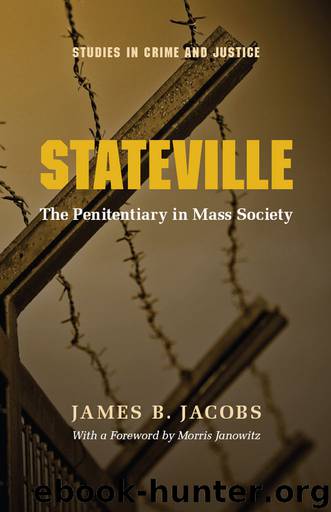Stateville- the Penitentiary in Mass Society by James B Jacobs

Author:James B Jacobs
Language: eng
Format: azw3, epub
ISBN: 9780226218830
Publisher: University of Chicago Press
Published: 2015-07-31T04:00:00+00:00
6
Penetration of the Gangs
The gang leaders have absolute control. T. could just have told his men to tear it down and they would—a lot of these guys would die for their gang—dying doesn’t mean anything to them. They’d rather die than let it be said that they wouldn’t go all the way.
Fifty-year-old black inmate (Stateville 1972)
The dominance of four Chicago street gangs at Stateville since 1969 must be related to the rise of professional administration and to the intrusion of the courts. The abandonment of the “hands off” doctrine exposed an authoritarian regime to outside accountability, limited the institution’s recourse to coercive sanctions and provided the inmates with a legitimate means of expression with which to challenge the system of social control. The rise of professional administration, informed by the rehabilitative ideal and the human relations model of management, led to intrastaff conflict, a decline in the morale of the guard force, and ultimately to the deterioration of the organization’s capacity to meet basic control and maintenance goals. It was only in the context of this organizational crisis that the gangs were able to organize, recruit, and achieve dominance.
The Politicization of Chicago Street Gangs
Three black gangs—the Blackstone Rangers (who later renamed themselves the Black P Stone Nation), the Devil’s Disciples (sometimes referred to as the Black Gangster Disciple Nation) and the Conservative Vice Lords—have been given extensive attention by the media and by scholars.1 The Latin Kings, while less well known nationally, seem to have followed a somewhat similar pattern of growth and development. Each of the four gangs is territorially based in Chicago’s slum districts, and, because of their great size, the relatively high age of their leaders, and their imperialistic annexation of smaller gangs they might aptly be termed “supergangs.”2
Not only are the supergangs larger and more violent than their predecessors of the past several decades but their location at the intersection of the civil rights movement, the youth movement, and a reconstructed relationship between the federal government and grassroots society suggests a divergence from the traditional street gang.3 Supporters of these gangs have interpreted their development as an evolution toward political and social consciousness.4 The police and other critics have defined the gangs’ flirtations with politics, community action, and minority movements as a thin facade, and have labeled those who have accepted the gangs as legitimate community organizations naive do-gooders.5
Beginning with the Kennedy administration, large amounts of federal monies became available for programs aimed at fighting juvenile delinquency.6 In 1965 Chicago received a $685,000 grant to coordinate all street work programs (“Streets”) in the city under the direction of City Hall. But, according to Lawrence Sherman, Streets failed to maintain a working relationship between the police and the social agencies for two complementary reasons: “its expanded purpose of social change and the changing socio-political environment.”7 Sherman attributes the termination of Streets to the aldermanic candidacy of detached gang worker Fred Hubbard in 1966. “The great fear at city hall was that Streets would channel gang members into the civil rights movement.
Download
Stateville- the Penitentiary in Mass Society by James B Jacobs.epub
This site does not store any files on its server. We only index and link to content provided by other sites. Please contact the content providers to delete copyright contents if any and email us, we'll remove relevant links or contents immediately.
Cecilia; Or, Memoirs of an Heiress — Volume 1 by Fanny Burney(32374)
Cecilia; Or, Memoirs of an Heiress — Volume 3 by Fanny Burney(31749)
Cecilia; Or, Memoirs of an Heiress — Volume 2 by Fanny Burney(31714)
The Great Music City by Andrea Baker(31086)
We're Going to Need More Wine by Gabrielle Union(18905)
All the Missing Girls by Megan Miranda(15391)
Pimp by Iceberg Slim(14211)
Bombshells: Glamour Girls of a Lifetime by Sullivan Steve(13927)
Talking to Strangers by Malcolm Gladwell(13131)
Norse Mythology by Gaiman Neil(13125)
Fifty Shades Freed by E L James(13120)
For the Love of Europe by Rick Steves(12340)
Crazy Rich Asians by Kevin Kwan(9123)
Mindhunter: Inside the FBI's Elite Serial Crime Unit by John E. Douglas & Mark Olshaker(9103)
The Lost Art of Listening by Michael P. Nichols(7359)
Enlightenment Now: The Case for Reason, Science, Humanism, and Progress by Steven Pinker(7083)
The Four Agreements by Don Miguel Ruiz(6541)
Bad Blood by John Carreyrou(6476)
Weapons of Math Destruction by Cathy O'Neil(6084)
